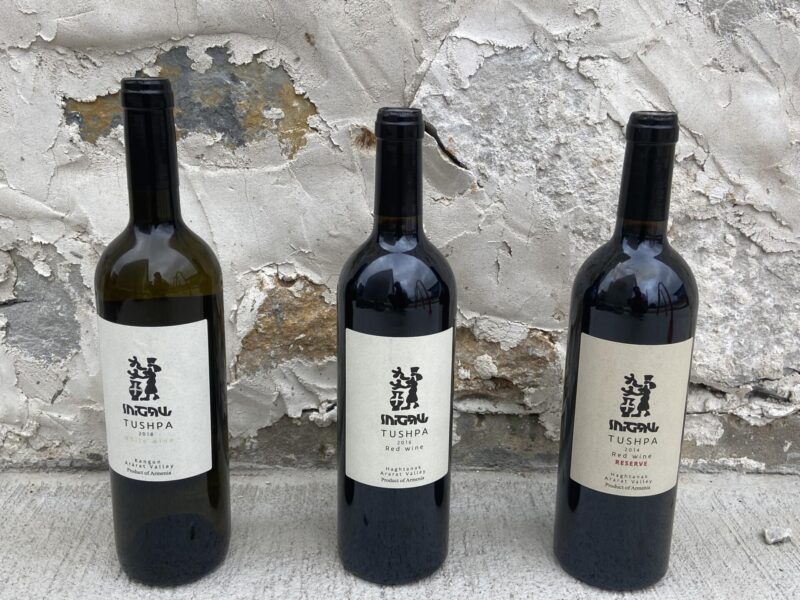It’s been a while since I introduced you to a varietal through my series “New Grape Ish.” Earlier this year, I was approached by a woman who handles social media for various international wine companies. She wanted me to try one of her client’s Armenian wines. Armenia was not a region that I associated with wine, so I was looking forward to learning more. She notified me that Tushpa Wine Cellar would be sending me three of their current releases: a white wine made with the Kangun grape, a red made with the Haghtanak grape, and their Reserve Haghatanak. I never even knew these two varietals existed so I knew I wanted to share with you in case you ever came across them on your wine journeys.
Rich History of Armenian Wine
Armenia has a long history of winemaking that dates back to 4000 B.C. in a little cave (known as Areni-1) nestled in the heart of Armenia. Areni-1 is home to the oldest wine making materials. It is found in the Vayots Dzor province in Southern Armenia. However, centuries later during the Soviet era, traditional winemaking was nearly erased from Armenia’s culture. From the 1930s through the early 90s, Armenian winemakers received instruction to mass-produce fortified wines and brandy rather than traditional Armenian table wines. Needing constant attention and supervision, many vineyards fell into disrepair, and it wasn’t until the late 1990s that winemakers started to revive the industry.
Armenia is a mountainous country and the vineyards are at high altitudes (often over 5,000 feet above sea level). The winters are cold and the summers dry and hot. Over the centuries Armenian grapes have perfectly adapted to these harsh conditions. Their wines are primarily made from unique Armenian varietals, which span over 100 different indigenous kinds.
A Look at Tushpa Wine Cellars
Tushpa Wine Cellar is a traditional Armenian winery, both owned and managed. It was founded in 1992 by the winemaker Mihran Manasserian. The winery is named for the historic area of Tushpa, now know as Van, from where many of Armenia’s ancestors originated. Located in the heart of the Ararat Valley, one of the world’s most ancient terroirs, Tushpa has six hectares of vineyards of Armenia’s native grapes Kangun and Haghtanak. Tushpa’s land is naturally endowed with the ideal soil and climate conditions. As a result, the Ararat Valley produces quality grapes that allow Tushpa’s winemaker to produce unique wines. In addition, they pride themselves on making their wines with minimal intervention to produce a true expression of their grapes’ character.
Now that you know a little bit more about Armenian wine, let’s take a look at the Kangun and Haghtanak varietals as I try some of Tushpa’s wines.
What is Kangun?
Kangun is a hybrid of the Georgian grape Rkatsiteli and several Armenian varietals created during the Soviet period in 1979. I blogged about Rkatsiteli in my last “New Grape Ish” post. It is one of the oldest grape varieties in the world. In Armenian Kangun means “firmly standing” for its reputation of high resistance to pests and various diseases. When carefully cultivated, Kangun produces a highly complex medium bodied white wine. Depending on winemaking techniques, the wine may preserve the prevalence of fresh white fruits and hints of citruses. In case of fermentation and aging in oak barrels, the wine develops with hints of bread and oak. It is often used in the production of dry and dessert white wines, as well as for premium quality brandy.
2018 Tushpa Kangun (White Wine)

The 2018 Tushpa white wine is made with 100% Ararat Valley native Kangun grape. As I mentioned, Tushpa wines are made with less intervention. In particular, very little natural yeast is added to this white wine to help with its fermentation. It’s light yellow in color, with a fruity and floral bouquet, with noticeable citrus notes, which add a crisp acidic note to this smooth yet dry wine. It pairs well with white meats, white fish, cheeses and light vegetables.
What is Haghtanak?
Haghtanak is Armenian for “victory.” Like the Kangun grape, it is a hybrid created in the Soviet period from the various Armenian varietals and the Georgian grape Saperavi. You may recall that I also covered the Saperavi varietal before. It’s another popular Georgian grape. When properly cultivated, Haghtanak makes dark wines with black fruit flavors.
2016 Tushpa Haghtanak (Red Wine)

This red wine is made from 100% Haghtanak grape grown in the Ararat Valley. It was spontaneously fermented and aged for seven months in Caucasian oak barrels. This full bodied red is pomegranate in color. It has an intense bouquet with black currant, cherries and vanilla notes. It pairs well with roasted meats or vegetables, or hard cheeses.
2014 Tushpa Haghtanak (Reserve)

The Reserve carries a lot of similar flavor characteristics as the original with the exception that it was aged longer.
I thoroughly enjoyed trying these wines. I don’t know when or if I’ll ever get the chance to visit Armenia so it was cool to experience some of it through these bottles. And the great part is so can you!
You can purchase these wines through Tushpa’s distributor website Cedar Wines. And guess what?! These wines are very affordable! Only $12 for the Kangun and Haghtanak wines and $26 for the Reserve bottle. If that’s not a steal, then I don’t know what is! Hope you learned something new and enjoyed today’s post. Until next time…glasses up!



